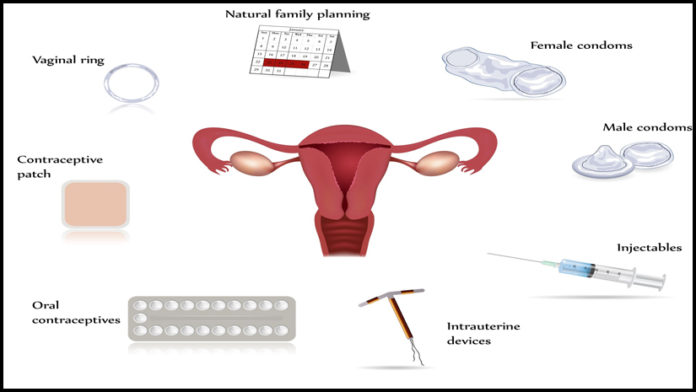Contraception is the deliberate use of artificial methods or techniques to prevent pregnancy during sexual intercourse. Contraception is essential during an intercourse, to avoid pregnancy “by chance”. Pregnancy should be a choice- this mantra is important. Contraception was not used earlier, as it was considered anti-religious by many orthodox families.
 Issue like age, family stature, relationship status, physical needs, finance, society etc. are the primary reasons, why youngsters use contraception as a means to prevent pregnancy- rather than concentrating on preventing pregnancy and also STDs – whatever be the priority – proper idea of contraception is required. For males the widely accepted tool to prevent pregnancy is condom, but the types of contraception, that is not extensively discussed and also lesser known contraception methods are female contraception methods.
Issue like age, family stature, relationship status, physical needs, finance, society etc. are the primary reasons, why youngsters use contraception as a means to prevent pregnancy- rather than concentrating on preventing pregnancy and also STDs – whatever be the priority – proper idea of contraception is required. For males the widely accepted tool to prevent pregnancy is condom, but the types of contraception, that is not extensively discussed and also lesser known contraception methods are female contraception methods.
 Since we have recognized the requirement for female contraceptives, you might need to investigate the business sector to choose your alternatives. This is the precarious part. Since there are such a large number of decisions, there is a probable risk that the sheer volume of data accessible on the subject may overpower you. So to straightforwardness things, here’s a rundown of 12 unique sorts of contraceptives that are promptly accessible and can be entirely viable.
Since we have recognized the requirement for female contraceptives, you might need to investigate the business sector to choose your alternatives. This is the precarious part. Since there are such a large number of decisions, there is a probable risk that the sheer volume of data accessible on the subject may overpower you. So to straightforwardness things, here’s a rundown of 12 unique sorts of contraceptives that are promptly accessible and can be entirely viable.
1. The combination pill What is it: This pill has a combination of estrogen and progestin hormones that suppress ovulation. Because of the two hormones the ovaries are unable to release an egg. These pills also cause changes in the lining of the uterus and cervical mucus to discourage sperms from sticking to them. These pills are also known to reduce hot flashes and regulate periods.
What is it: This pill has a combination of estrogen and progestin hormones that suppress ovulation. Because of the two hormones the ovaries are unable to release an egg. These pills also cause changes in the lining of the uterus and cervical mucus to discourage sperms from sticking to them. These pills are also known to reduce hot flashes and regulate periods.
They are available as Estrostep Fe, LoEstrin 1/20, Ortho-Novum 7/7/7, Ortho Tri-Cyclen Lo, Yasmin and Yaz in the market.
Dosage: These pills are taken every day at the same time for 21 days a month. For the next seven days, you have to go off the pill to let the ovaries release the egg and stimulate a normal period.
When you should not use it : Those who smoke and are over 35 years of age, have high level of estrogen, which can cause blood clots. You should also avoid this pill if you suffer from migraines.
2. Progestin pill or mini pill What is it: This pill is often called the mini pill since it does not have estrogen. These pills thicken the cervical mucus and thin the lining of the uterus.
What is it: This pill is often called the mini pill since it does not have estrogen. These pills thicken the cervical mucus and thin the lining of the uterus.
These pills are safe for smokers, diabetics and those who may be at risk of forming blood clots. Mini pills also do not reduce breast-milk supply in the future.
They are available as Micronor, Nora-BE, Nor-QD and Ovrette in the market.
Dosage: They work the same way as a combination pill and have to be consumed at the exact same time each day.
When you should not use it: You have or have had breast cancer, liver disease, bariatric surgery or are on medication for HIV, tuberculosis or cannot take the pill at the exact same time each day.
3. Extended-cycle pill What is it: These female contraceptives prevent unwanted pregnancy and allow their user to go through the menstrual cycle once every three months. These are available as Lybrel, Seasonale and Seasonique in the market.
What is it: These female contraceptives prevent unwanted pregnancy and allow their user to go through the menstrual cycle once every three months. These are available as Lybrel, Seasonale and Seasonique in the market.
Dosage: These pills are also to be consumed once a day at the exact same time. However, it’s best to consult your doctor before you start them because some of them can cause prolonged intervals before the next menstrual cycle.
When you should not use it: You want to have a menstrual cycle each month. While there are no studies that have so far proved that prolonging your period is harmful for the body, there is no research to prove otherwise as well.
4. Contraceptive patch What is it: This patch contains hormones similar to vaginal ring or birth control pills that prevent unwanted pregnancy. These usually come as a small beige patch.
What is it: This patch contains hormones similar to vaginal ring or birth control pills that prevent unwanted pregnancy. These usually come as a small beige patch.
It is available as Ortho Evra in the market. You can always consult your doctor before actually buying the product.
Dosage: The patch is used once a week for an entire week. This process is carried on for three weeks, followed by a patch-free week.
When you should not use it: You are at a high risk of developing blood clots since the patch delivers almost 60 percent high level of estrogen than normal contraceptive pill.
5. Vaginal Ring What is it: Made of flexible plastic, this ring contains estrogen and progestin just like the combination pill. This pill prevents the ovaries from releasing mature eggs. It is available in the market as NuvaRing.
What is it: Made of flexible plastic, this ring contains estrogen and progestin just like the combination pill. This pill prevents the ovaries from releasing mature eggs. It is available in the market as NuvaRing.
Dosage: It is an invasive procedure where the ring is placed inside the vagina for three weeks and then removed for a week for normal periods to take place.
When you should not use it: You experience blood clots in your legs, arms or feet. Alternatively, you should avoid if you have been diagnosed with cancer.
6. Diaphragm What is it: This is a rubber-based female contraceptive, which is manufactured in the shape of a dome. It prevents the sperm from fertilizing the egg in the ovaries. A diaphragm ideally covers the cervix of the uterus and must be used with a spermicide.
What is it: This is a rubber-based female contraceptive, which is manufactured in the shape of a dome. It prevents the sperm from fertilizing the egg in the ovaries. A diaphragm ideally covers the cervix of the uterus and must be used with a spermicide.
Although it may be available off-the-counter at your nearest drugstore, it is advisable to get it fitted by a doctor.
Dosage: It is used to prevent unwanted pregnancy and can be used just as a regular female condom is used. The days to be used must be consulted with the doctor.
When you should not use it: You have ever suffered from toxic shock syndrome then you must avoid using a diaphragm.
7. Intrauterine Device What is it: An Intrauterine Device (IUD) is surgically implanted copper device, which prevents sperms from coming in contact with the egg. These are available as Mirena and ParaGard in the market.
What is it: An Intrauterine Device (IUD) is surgically implanted copper device, which prevents sperms from coming in contact with the egg. These are available as Mirena and ParaGard in the market.
These IDUs could be medicated with progesterone and on insertion into the vagina release the hormones. This hormone prevents sperm motility. It also thins the lining of the uterus, thereby, preventing sperms from attaching to them or the eggs.
Dosage: This is another type of invasive female contraceptive where the IUD is inserted into the vaginal cavity. It is ideally used for a period of two or more years.
When you should not use it : You have never given birth or plan to get pregnant in the next two years.
8. Female condom What is it: A female condom is made of soft rubber or plastic or polyurethane. It prevents the sperms from entering the uterus and cause unwanted pregnancy or sexually transmitted diseases (STDs). It is inserted deep into the cervix and works just like the diaphragm.
What is it: A female condom is made of soft rubber or plastic or polyurethane. It prevents the sperms from entering the uterus and cause unwanted pregnancy or sexually transmitted diseases (STDs). It is inserted deep into the cervix and works just like the diaphragm.
However, a male condom is more effective than a female condom. It prevents both- STDs and unwanted pregnancy. They are sold as Femy, Protectiv and Reality in the market.
Dosage: A female condom can be inserted into the cervix about eight hours before intercourse.
When you should not use it: You are not in a long-term monogamous relationship with your partner. One should remember to not use the female condom, if your partner is using a condom, because there is a high chance of tear due to friction.
9. Birth-control shot What is it: This shot is usually given by a doctor once every month or once every three months. It is a long-lasting hormonal method that provides effective contraception.
What is it: This shot is usually given by a doctor once every month or once every three months. It is a long-lasting hormonal method that provides effective contraception.
You may experience weight gain, headaches, dizziness, pimples and greasy skin, bloating, weight gain, breast tenderness, abdominal discomfort, and changes in mood and sex drive.
Since the hormones cannot be removed from the body once the injection has been administered, side effects may continue from the time of the injection and for some time afterwards.
They are available as Depo-Provera, or DMPA shot in the market.
Dosage: This injection is usually taken once for every three months.
When you should not use it: You have a fluctuating weight or have suffered from ectopic pregnancy.
10. Implant What is it: One or two small, soft, plastic rods containing a progestogen reservoir are inserted under the skin of the upper arm. This done in a minor surgery which should be carried out by a trained doctor, midwife or nurse.
What is it: One or two small, soft, plastic rods containing a progestogen reservoir are inserted under the skin of the upper arm. This done in a minor surgery which should be carried out by a trained doctor, midwife or nurse.
The progestogen is released in tiny doses through this implant. You will get this implant called Implanon or Norplant from the doctor and it is not available off-the-counter.
It can be removed at any time by minor surgery. The implant is particularly suitable for women who want long-term contraception and wish to avoid daily intake of a contraceptive. It is also suitable for women who are breast-feeding.
Fertility will return to normal when the implant is removed. An additional benefit is that it may also reduce heavy, painful periods.
Dosage: The female contraceptive implant is usually effective for three to five years.
Some women may experience headaches, breast tenderness, bloating and changes in mood and increased sex drive.
Irregular bleeding may occur for the first few months.
When you should not use it: You are overweight and struggle to maintain a constant weight.
11. Emergency pill (morning-after pill) What is it: Women can use the emergency pill almost immediately after unprotected intercourse. The emergency pill works by inhibiting ovulation. It is available as i-pill in the market.
What is it: Women can use the emergency pill almost immediately after unprotected intercourse. The emergency pill works by inhibiting ovulation. It is available as i-pill in the market.
This emergency method of contraception can be used if unprotected sex has taken place or when another method of contraception has failed (e.g. a torn condom or forgotten pill).
It should not be used regularly, and is only intended as a back-up method.
Dosage: Ideally, one should take the pill within 12 hours, but you can take it up to 72 hours after unprotected intercourse. The sooner you take it, the more effective it will be.
When you should not use it: You have had problems of blood clotting or irregular periods.
12. Female sterilization What is it: In this surgical procedure the Fallopian tubes (which carry the egg from the ovary to the womb) are cut or blocked. This prevents the sperm from meeting the egg.
What is it: In this surgical procedure the Fallopian tubes (which carry the egg from the ovary to the womb) are cut or blocked. This prevents the sperm from meeting the egg.
The operation affects a woman’s fertility potential and has no effect on the libido or the ability to have sexual intercourse.
Sterilization is only for people who have decided they definitely do not want to have children, either now or in the future. Although there is a chance of reversal, the procedure is complicated and rarely successful.
Very occasionally, there can be a technical failure during the procedure where the Fallopian tubes reopen, or closure is incomplete.
Dosage: It is done once in a lifetime and is irreversible.
When you should not use it: You are still in the process of planning another pregnancy.
By these 12 distinct ways one can go for compelling contraception. These are completely risk free and hazardless.
-By NB




























